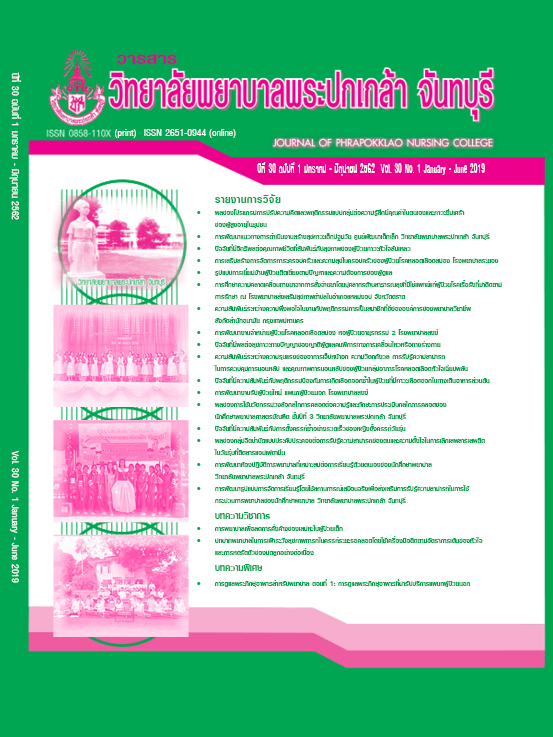Nurse’s Roles in Intrapartum Fetal Surveillance Using the Continuous Cardiotocography
Keywords:
Nurse’s roles, Intrapartum fetal surveillance, Continuous cardiotocographyAbstract
Nursing care during intrapartum period was from onset until fully dilatation. This period is a very important and take a long time for mothers and babies. The normal progress of labor depends on many factors. In this period, the risk and emergencies often occur every minute, especially fetal distress condition that could lead to fetal hypoxia and stillbirth. Intrapartum fetal surveillance is a vital task and challenging for labor nurses. Intermittent auscultation (IA) is a popular and effective method to assess fetal well being. At the present, variant technologies are used for intrapartum fetal surveillance. For example, continuous cardiotocography (CTG) is used in labor room because it is easy and convenient way to get results. However, nurses must have experiences and skills for CTG. Labor nurses who care for intrapartum period clients closely have to adjust and learn how to use CTG and interpret the results for risk assessment, surveillance, emergency diagnosis, provide emergencies nursing care, and coordinate with health team in order to keep mothers and babies’ safe delivery.
References
คณะอนุกรรมการฝ่ายวิชาการ พ.ศ. 2558-2559 สมาคมเวชศาสตร์ปริกำเนิดแห่งประเทศไทย. (2559). การบริบาลปริกำเนิด: จากทฤษฎีสู่ปฏิบัติ. กรุงเทพฯ: ยูเนี่ยน ครีเอชั่น.
ไพรินทร์ สุคนธ์ตระกูล. (2559). ความก้าวหน้าของการคลอดกับบทบาทพยาบาลผดุงครรภ์. วารสารพยาบาลทหารบก, 17(2), 1-6.
วรุณสิริ หงส์ลดารมภ์, และสุพัตรา ศิริโชติยะกุล. (2554). Fetal surveillance. สืบค้นจาก https://www.med.cmu.ac.th/dept/obgyn/2011/index.php?option=com_content&view=article&id=662%3Afetal-surveillance&catid=45&Itemid=561
Alfirevic, Z., Devane, D., Gyte, G. M. L., & Cuthbert, A. (2017). Continuous cardiotocography (CTG) as a form of electronic fetal monitoring (EFM) for fetal assessment during labour. Retrieved from https://www.cochranelibrary.com/cdsr/doi/10.1002/14651858.CD006066.pub3/full
Edmonds, J. K., & Jones, E. J. (2013). Intrapartum nurses’ perceived influence on delivery mode decisions and outcomes. Journal of Obstetric, Gynecologic & Neonatal Nursing, 42(1), 3-11.
Nursing management during labor and birth. (n.d.). Retrieved from http://downloads.lww.com/wolterskluwer_vitalstream_com/sample-content/9780781752206_Ricci/samples/Chapter14.pdf
Pinas, A., & Chandraharan, E. (2016). Continuous cardiotocography during labour: Analysis, classification and management. Best Practice & Research, Clinical Obstetrics & Gynaecology, 30, 33-47.
Robin, E. W. (2018). Normal fetal heart rate during pregnancy. Retrieved from https://www.verywellfamily.com/
Schneider, K. T. M. (2014). Guideline on the use of CTG during pregnancy and labor. Retrieved from https://www.ncbi.nlm.nih.gov
The Healthline Editorial Team. (2018). Fetal heart monitoring: What’s normal, what’s not?. Retrieved from https://www.healthline.com/health/pregnancy/abnormal-fetal-heart-tracings
World Health Organization. (2018). WHO recommendation on duration of the first stage of labour. Retrieved from https://extranet.who.int/
Downloads
Published
How to Cite
Issue
Section
License
Copyright (c) 2019 JOURNAL OF PHRAPOKKLAO NURSING COLLEGE

This work is licensed under a Creative Commons Attribution-NonCommercial-NoDerivatives 4.0 International License.
เนื้อความ ข้อมูล และรายการอ้างอิงที่ผู้เขียนใช้ในการเขียนบทความเพื่อลงตีพิมพ์ในวารสารวิทยาลัยพยาบาลพระปกเกล้า จันทบุรี ถือเป็นความคิดเห็นและความรับผิดชอบของผู้เขียน คณะผู้จัดทำวารสารไม่จำเป็นต้องเห็นพ้องด้วยหรือร่วมรับผิดชอบ
บทความที่ได้รับการลงตีพิมพ์ในวารสารวิทยาลัยพยาบาลพระปกเกล้า จันทบุรี ถือเป็นลิขสิทธิ์ของวารสารวิทยาลัยพยาบาลพระปกเกล้า จันทบุรี หากหน่วยงานหรือบุคคลใดต้องการนำส่วนหนึ่งหรือทั้งหมดของบทความไปเผยแพร่ต่อเพื่อวัตถุประสงค์ใด ๆ จะต้องได้รับอนุญาตจากบรรณาธิการวารสารก่อน



